|
|
|
Sort Order |
|
|
|
Items / Page
|
|
|
|
|
|
|
| Srl | Item |
| 1 |
ID:
138438


|
|
|
|
|
| Summary/Abstract |
As Army chief of staff, secretary of state, and secretary of defense, George C. Marshall played a major role in creating, implementing, and defending the multilateral “Europe-First” global strategy that guided U.S. foreign and military policies through World War II and the Cold War. This lecture explores how and why he did so, emphasizing the decision to defeat Germany before Japan, the postwar European Recovery Program that bears Marshall’s name, and the relief of General Douglas MacArthur during the Korean War for his refusal to accept this grand strategy. In the process it analyzes the complex relationship that exists between diplomatic and military history.
|
|
|
|
|
|
|
|
|
|
|
|
|
|
|
|
| 2 |
ID:
137507
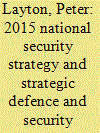

|
|
|
|
|
| Summary/Abstract |
In devising the 2015 National Security Strategy (NSS) and Strategic Defence and Security Review (SDSR), British decision-makers have a choice between trying to shape international affairs to be more favourable or instead planning to respond meaningfully to events that arise. The former grand strategic approach appears favoured however, the latter risk management approach remains the basis for work. That the two approaches are incompatible, distinctly dissimilar and would yield markedly different NSS and SDSR outcomes is generally overlooked. Moreover, opportunism, a third viable approach has been neglected. This article evaluates the three approaches, ascertains their principal advantages and weaknesses and outlines three alternative NSSs and SDSRs based on the different approaches.
|
|
|
|
|
|
|
|
|
|
|
|
|
|
|
|
| 3 |
ID:
154876
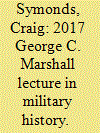

|
|
|
|
|
| Summary/Abstract |
Of all the various ways that American participation in World War II contributed to Allied victory, the most critical, and in the end the most decisive, was American industrial productivity, and particularly shipbuilding. United States ship construction between 1941 and 1945 dramatically outstripped both its own allies and all of its foes combined. The United States was not only the “arsenal of democracy” (Franklin Roosevelt’s phrase) but also the Allies’ shipbuilder, and superiority in shipping is what allowed the Allies to win the Battle of the Atlantic, conduct the D-Day invasion, and mount a simultaneous offensive in the Pacific.
|
|
|
|
|
|
|
|
|
|
|
|
|
|
|
|
| 4 |
ID:
162039
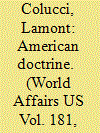

|
|
|
| 5 |
ID:
103844
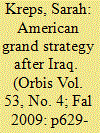

|
|
|
|
|
| Publication |
2009.
|
| Summary/Abstract |
To the extent that a grand strategy can be discerned in the first year of the Obama Administration, its defining features are not a break from the past but continuity. As the President himself has analogized since taking office, crafting grand strategy is like parallel parking. He has only been able to make changes to grand strategy around the margins since a number of existing commitments limit his freedom of action. This article first identifies the structural determinants of grand strategy, pointing to the international distribution of power, American bureaucracy, and public as the key sources of strategic constraint and opportunity. It then shows how shifts in these factors-comparatively less U.S. power, an overstretched military organized around counterinsurgency operations in Iraq and Afghanistan, and an American public weary from an aggressive grand strategy-produced a shift in grand strategy that predated the 2008 election and that remains consistent with the current strategic setting. It is for these reasons that the 2008 "change" election has produced considerable continuity in American grand strategy.
|
|
|
|
|
|
|
|
|
|
|
|
|
|
|
|
| 6 |
ID:
061093
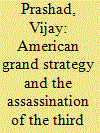

|
|
|
| 7 |
ID:
103843
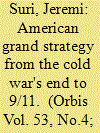

|
|
|
|
|
| Publication |
2009.
|
| Summary/Abstract |
Grand strategy is about making sense of complexity; it is the wisdom to make power serve useful purposes. After the end of the Cold War, American policymakers sought to create a new grand strategy for the United States, but they failed in this endeavor. They failed because of difficult domestic and international circumstances. They also failed because of conceptual limitations. This article traces the efforts at strategy formulation in the administrations of George H. W. Bush and Bill Clinton, and it analyzes their shortcomings. Bush had process without purpose; Clinton had purpose without process. The article encourages readers to think about how future strategists might improve upon this legacy with clearer and more disciplined attention to priorities, capabilities, and trade-offs. Making grand strategy in a democracy is not easy, but it is necessary. The absence of effective grand strategy in the 1990s contributed to the crises of the early twenty-first century.
|
|
|
|
|
|
|
|
|
|
|
|
|
|
|
|
| 8 |
ID:
065227
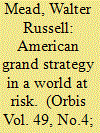

|
|
|
| 9 |
ID:
065556
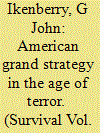

|
|
|
| 10 |
ID:
169216
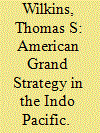

|
|
|
|
|
| Summary/Abstract |
In an era of heightened great power competition, debates about American grand strategy in the Indo-Pacific region have returned to the fore. This review essay looks at three recent volumes that directly address such debates. After introducing the concept of grand strategy, Part I reviews each of the books individually in sequence, outlining their scope, contents, and contributions. Part II then integrates the contribution of each of the volumes into a broader discussion relating to four pertinent issues: American perspectives on “Asia”; international relations (IR) theory; American strategic culture; and the rise of China, before concluding. The books under review are to differing degrees orientated toward one of the core IR theory paradigms: realism (Green), liberalism (Campbell), and constructivism/critical (Kang) approaches. As such, read together, they contribute to a multi-faceted theoretical understanding of US grand strategy in the Indo Pacific that will be of significant value to both scholars and practitioners.
|
|
|
|
|
|
|
|
|
|
|
|
|
|
|
|
| 11 |
ID:
076848
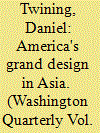

|
|
|
|
|
| Publication |
2007.
|
| Summary/Abstract |
In a dynamic Asian order featuring new centers of power, China's rise will naturally challenge Washington's ability to protect its interests in the region. In 2000, presidential candidate George W. Bush labeled China as the United States' leading strategic and military competitor. In September 2005, Deputy Secretary of State Robert Zoellick explicitly warned Beijing not to "maneuver toward a predominance of power" in Asia, suggesting that it was doing exactly that.
In the face of this challenge, the United States has strengthened the two pillars of its Cold War-era regional security posture: its hub-and-spoke system of bilateral military alliances and its forward-deployed military forces. Washington has reconfigured its permanent troop deployments in Japan and South Korea, tightened its alliance with Australia, declared Thailand and the Philippines to be major non-NATO allies, and signed a wide-ranging strategic cooperation agreement with Singapore. Meanwhile, the Pentagon has deployed significant new power-projection capabilities to the region, including attack submarines, cruise-missile destroyers, long-range bombers, and fighter aircraft stationed in Guam.
To these two preexisting pillars of its Asian security strategy, the United States is adding a third, designed to hedge against the danger of Chinese hegemony in Asia by limiting and constructively channeling China's regional ambitions. U.S. policy seeks to accelerate the economic and military rise of key Asian states with the power potential and ambitions to constrain China's ability to dominate its region. The United States is not working to contain China. Rather, U.S. policymakers are employing a radically different strategy: to preserve Washington's strategic position in the region by facilitating the ascent of friendly Asian centers of power that will both constrain any Chinese bid for hegemony and allow the United States to retain its position as Asia's decisive strategic actor. In the face of the China challenge, the United States is encouraging the emergence of new centers of strength that will not erode U.S. power but protect the U.S. position in a new Asian balance featuring emerging world powers in China, Japan, and India.
|
|
|
|
|
|
|
|
|
|
|
|
|
|
|
|
| 12 |
ID:
106881
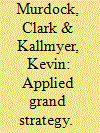

|
|
|
|
|
| Publication |
2011.
|
| Summary/Abstract |
This article hopes to contribute to the strategic content of U.S. foreign policy by offering a definition of grand strategy and case for reorienting U.S. policy around it. Rather than advocate a specific grand strategy-a matter still open for debate-the analysis concludes with a set of attributes to assess whether a proposed grand strategy constitutes a "good" grand strategy. It concludes by introducing the concept of an applied grand strategy approach, which may help to identify and assess the strategic implications of foreign policy choices.
|
|
|
|
|
|
|
|
|
|
|
|
|
|
|
|
| 13 |
ID:
102419
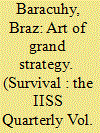

|
|
|
|
|
| Publication |
2011.
|
| Summary/Abstract |
It seems almost paradoxical that the study of 'grand strategy', broadly understood as the international vision pursued by the foreign policy of a state, has been to a large extent neglected by international-relations scholars. This lack of attention to a concept that is nearly intuitive to diplomatic practice says much about how International Relations (the field of study) became divorced from international relations (the real world of 'politics among nations', to borrow Hans Morgenthau's formulation). As the field moved away from its classical roots, international-relations theorists became obsessed with modelling politics after the natural sciences. The application of an economics paradigm to international politics saw states rendered as rational actors that maximise goals and respond to structural stimuli just as companies do in the market. Positional analysis became more important than strategic conception.
|
|
|
|
|
|
|
|
|
|
|
|
|
|
|
|
| 14 |
ID:
166012
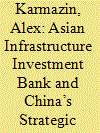

|
|
|
|
|
| Summary/Abstract |
Creating the Asian Infrastructure Investment Bank (AIIB), a multilateral development bank initiated by the People’s Republic of China, has been one of the key symptoms of Xi Jinping’s ambitious “China Dream” foreign policy. The previous studies mainly focused on providing a description of AIIB’s creation or general motives and context through which they explicated the establishment of the Bank. Building on the literature focused on strategic culture and grand strategy, I supplement the general motives of AIIB’s creation by characterizing the style and process of AIIB’s materialization. I argue that the style (procedure) of AIIB’s implementation largely resembles the previous Dengian model of strategic procedure which Deng himself described with the Chinese saying “crossing the river by touching the stones” which evinces flexibility and “step-by-step” characteristics in its procedure. This helps to illustrate that China’s engagement with the international order can be adaptive to a significant degree and China does not necessarily follow a pre-planned vision of how to take over international (institutional) order. While China’s foreign policy in some areas is often regarded as being assertive and rigidly defending its positions, AIIB is a different case to a high extent. Moreover, analyzing the creation of AIIB indicates ambiguity of Xi’s foreign policy regarding general aims it wants to achieve and identities on which it should be based.
|
|
|
|
|
|
|
|
|
|
|
|
|
|
|
|
| 15 |
ID:
106805
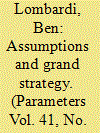

|
|
|
| 16 |
ID:
144533
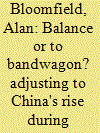

|
|
|
|
|
| Summary/Abstract |
This article examines Australian grand strategy in the context of China's rise during the period of Labor governments between 2007 and 2013. Australia's grand-strategic posture is treated as the dependent variable, plotted along a balancing-to-bandwagoning continuum. Australia remained within the hedging zone throughout, although there were discernible shifts in posture during the period. While momentum was building towards a more overt balancing posture during the Kevin Rudd era, the various balancing and bandwagoning ‘signals’ were more contradictory after Julia Gillard unseated Rudd 2010; in short, she stabilised Australia's grand-strategic posture, meaning it remains best characterized as ‘dominance denial’.
|
|
|
|
|
|
|
|
|
|
|
|
|
|
|
|
| 17 |
ID:
155240
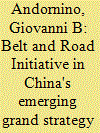

|
|
|
|
|
| Summary/Abstract |
As Chinese leaders endeavor to maintain the international environment aligned with their strategic aim of realizing the “dream of national rejuvenation,” the remarkable increase in China's capabilities, coupled with uncertainty in the global economy and the ambivalent attitude of the USA toward the international order, poses fresh challenges to Beijing's foreign policy. The present paper argues that a lexicographic preference for the mitigation of the risk of pushback against China's core interests underpins the Belt and Road Initiative. Pursuing a strategy of credible reassurance commensurate to the shift in the distribution of power in China's neighborhood and globally, President Xi Jinping's administration has been cultivating a form of connective leadership that commits China to the encapsulation of the Belt and Road Initiative for transregional connectivity into its own national development strategy, generating an octroyé, non-hegemonic, type of international social capital, and integrating the existing order without corroborating the position of its founder.
|
|
|
|
|
|
|
|
|
|
|
|
|
|
|
|
| 18 |
ID:
087649
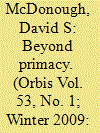

|
|
|
|
|
| Publication |
2009.
|
| Summary/Abstract |
The George W. Bush administration embraced a particularly aggressive counter-terrorist and counter-proliferation strategy after the 9/11 terrorist attacks. The "Bush Doctrine," as it became known, reflects a "primacist" approach to grand strategy that aims not only to eliminate global terrorist networks and cowl rogue state proliferators, but also to dissuade potential near-peer competitors from challenging the American-centred international system. Critics expect that this ambitious approach to strategic affairs has become unsustainable in the face of the growing quagmire in Iraq. But "security addiction" in the post-9/11 environment has instead created conditions for a bipartisan consensus on the overall direction, if not the particular modalities, of "primacist" grand strategies. Despite the unpopularity of the Bush administration and significant American commitments to Afghanistan and Iraq, it is highly unlikely that President Barack Obama will heed calls for military retrenchment or strategic restraint.
|
|
|
|
|
|
|
|
|
|
|
|
|
|
|
|
| 19 |
ID:
158408
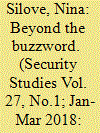

|
|
|
|
|
| Summary/Abstract |
The questions of how to define grand strategy and whether it “exists” continue to vex the study of grand strategy, despite the ever-increasing popularity of the term. Scholars broadly agree that grand strategy refers to something that has the characteristics of being long-term in scope, related to the state's highest priorities, and concerned with all spheres of statecraft (military, diplomatic, and economic). The precise entity or phenomenon that manifests these characteristics is less clear, indicating deficiencies in the methods used by scholars—usually implicitly—to define and operationalize concepts. This article traces the intellectual history and contemporary usage of the concept of grand strategy to identify the phenomenon or object to which the concept refers. This analysis demonstrates that there is no single concept of grand strategy. Instead, there are three, which are labelled “grand plans,” “grand principles,” and “grand behavior,” respectively. Each concept provides a distinct, valuable framework for research and policy prescription.
|
|
|
|
|
|
|
|
|
|
|
|
|
|
|
|
| 20 |
ID:
061091
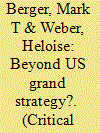

|
|
|
|
|
|
|
|